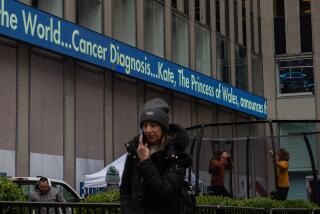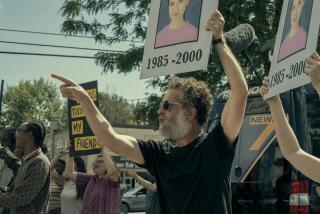Painless Solutions for the Hurts of Children
- Share via
SEATTLE — When it comes to describing their backaches and sore joints, adults are eloquent.
Small children, on the other hand, have not yet memorized the vocabulary of hurt and cannot easily convey how they feel.
At the 4th World Congress on Pain held here, researchers argued that because children’s feelings are not always understood, they are often seriously undermedicated for post-operative and chronic cancer pain.
At the last World Congress on Pain, held in Edinburgh, Scotland, in 1981, there were two papers on the topic of children and pain. At the congress three years before that, the topic wasn’t even on the agenda. For the first time, in Seattle, half a day was devoted to new findings in assessing and managing children’s pain.
“We know so little about children’s pain,” said Judith Beyer, a post-doctoral fellow in nursing at the University of Rochester. “We all manage it differently. We, as clinicians and researchers, have a lot of work to do.”
First Step The first step toward improving pain management in youngsters, Beyer said, is finding ways to assess childhood pain. Physicians and nurses are able to get accurate readings of adults’ pain by administering the McGill Pain Questionnaire and/or the Visual Analogue Scale. Such scales for children are still in the experimental stages.
And while health care workers are able to recognize pain behaviors in adults, spotting pain in a child can be as difficult as diagnosing hurt in an injured sparrow or the family cat.
“They don’t look like they’re in pain,” said Mary Ellen Jeans, associate dean of nursing at McGill University in Montreal. A child recovering from major surgery may sleep well at night and engage in vigorous play--quite unlike an adult following the same procedure.
Jeans has children draw pictures of their pain. The resulting illustrations often show the exact location of the irritation, she said, with the trouble spot colored black or red. The drawings indicate the nature of the pain as well--one boy drew corks in his stomach to suggest a feeling of blockage.
Other assessment tools introduced at the congress: Children count out poker chips to indicate how many “pieces of hurt” they are feeling. Young patients adjust a lamp according to the “brightness” of their pain.
Beyer uses a set of photographs of a child’s face showing a spectrum of emotions ranging from content to distraught. Children select the face that they identify with at the moment. Beyer calls the graph the “oucher.”
Jeans said nurses at McGill are experimenting with a pain ladder. Children in the ward have become so attuned to its use that as a nurse enters the room, a child often cries out: “I’m on rung four,” or “Rung nine!”
Celeste Johnston, director of nursing at Montreal Children’s Hospital, said nurses she works with are eagerly awaiting refinement of tools that will help them determine how much pain management their patients require. “It is very much a nursing problem because nurses spend 24 hours a day with the infants,” she said. “They’re the ones responsible for comforting babies.”
Johnston is working on interpretation of pain in infants. With the help of a computer, she has been able to isolate a distinct type of cry that signals pain, Johnston said. She’s also attempting to identify pain postures in infants--a rigid body and splayed toes may indicate pain as opposed to other sorts of distress, she said.
For years, it was widely believed that infants’ neurological pathways had not completely developed. So, it was thought, infants were not able to feel the full range of pain. However, Johnston said, all you have to do is watch a 2-day-old baby get a heel-prick blood test to know that babies feel the poke.
Doctors have been hesitant to give painkillers to babies for fear of depressing their respiratory functions, or sedating them to the point where they won’t eat, Johnston said. There is also concern that drugged babies may become addicted to their painkillers.
Self-Help Methods Until a child is at least 6, he or she is likely to deny any need for painkillers because the pay off doesn’t seem worth the price. “They (kids) can’t stand needles,” Johnston explained.
Jeans insisted that to get around the terror of the needle, nurses have to find “more imaginative” ways of administering relief. She suggested prescribing analgesics orally, or intravenously for children who are already on I.V.s.
Nurses should be encouraged to stroke and hold infants to help alleviate pain, she said. Older children who must face repeated painful procedures can be taught biofeedback and other techniques as alternatives to excessive medication.
Children are naturally good at coming up with ways to make themselves feel better, Jeans said. While adults suffering chronic pain are often at a loss for what to do to ease their own pain, children in one survey were able to list an average of four self-help methods such as imagining themselves in a happy fantasy.
Johnston said studies have shown that children who suffer unrelieved pain in the hospital may react with regressive episodes, nightmares and bed wetting for months after the event. This suggests to some researchers that childhood pain may have lasting psychological consequences.
Yet pain control is often last on the list of priorities when a child is hospitalized. “Assessing pain and learning about the pharmacology of analgesics is time-consuming and the average physician doesn’t have the time,” said pain consultant Ada Rogers.
Rogers’ official title at Memorial Sloan-Kettering Cancer Center in New York is research associate, clinical coordinator analgesic studies section. But children hospitalized there know her as “the pain lady.”
When she went to work in the pediatrics department 13 years ago, Rogers said she found children were routinely undermedicated. Residents rotating in every month from the general hospital had little understanding of children’s pain.
Rogers worked with parents who said they were desperate for some sort of a guide to interpreting their child’s pain. Parents have proven little better than doctors or nurses at picking up on pain cues--Rogers said one little girl who was later diagnosed as having a brain tumor had been telling her mother for months: “My hair hurts.”
“Children are in a quandary,” Rogers said. “Should they complain about their pain? Will they get punished? Even if they decide it’s safe to talk about what hurts, children have no concept that drugs can relieve pain, so they don’t think to ask for analgesics.”
Rogers invites them to discuss the topic: “I work with pain and I’m here to help you with your pain,” she tells them. “It’s all right to have pain.”
Proper pain control can make everything about illness and hospitalization a little easier for a child, and his or her family, Rogers said. “Then, even if the child dies, the parents are happy that their child did not die in pain.




